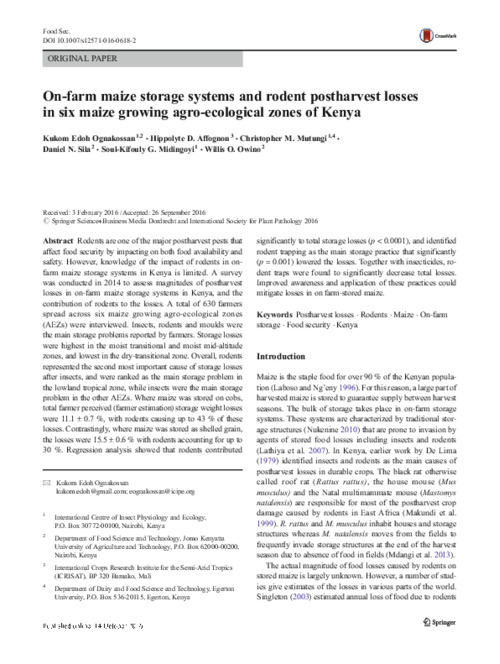On-farm maize storage systems and rodent postharvest losses in six maize growing agro-ecological zones of Kenya
Abstract
Rodents are one of the major postharvest pests that
affect food security by impacting on both food availability and
safety. However, knowledge of the impact of rodents in onfarm
maize storage systems in Kenya is limited. A survey
was conducted in 2014 to assess magnitudes of postharvest
losses in on-farm maize storage systems in Kenya, and the
contribution of rodents to the losses. A total of 630 farmers
spread across six maize growing agro-ecological zones
(AEZs) were interviewed. Insects, rodents and moulds were
the main storage problems reported by farmers. Storage losses
were highest in the moist transitional and moist mid-altitude
zones, and lowest in the dry-transitional zone. Overall, rodents
represented the second most important cause of storage losses
after insects, and were ranked as the main storage problem in
the lowland tropical zone, while insects were the main storage
problem in the other AEZs. Where maize was stored on cobs,
total farmer perceived (farmer estimation) storage weight losses
were 11.1 ± 0.7 %, with rodents causing up to 43 % of these
losses. Contrastingly, where maize was stored as shelled grain,
the losses were 15.5 ± 0.6 % with rodents accounting for up to
30 %. Regression analysis showed that rodents contributed significantly to total storage losses (p < 0.0001), and identified
rodent trapping as the main storage practice that significantly
(p = 0.001) lowered the losses. Together with insecticides, rodent
traps were found to significantly decrease total losses.
Improved awareness and application of these practices could
mitigate losses in on farm-stored maize

